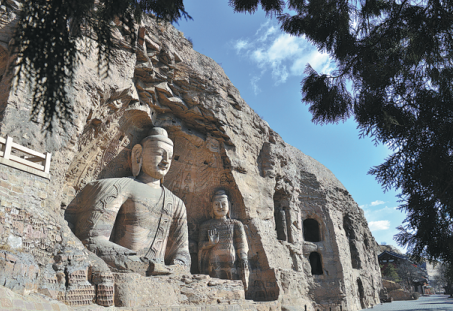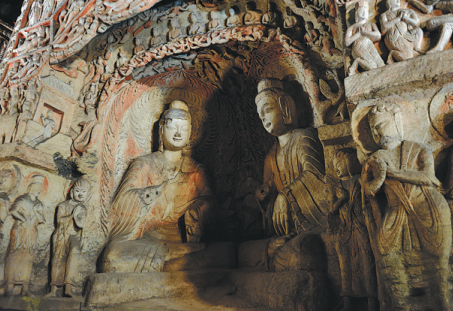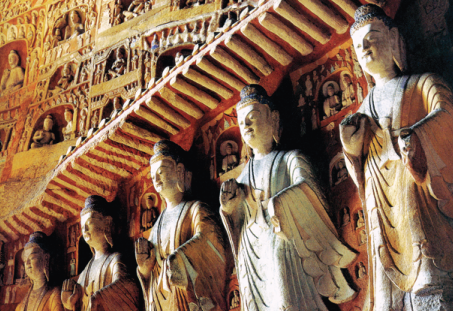Cultural landmark underwent years of conservation work that cost millions
Updated: 2020-05-22

The sitting Buddha in the 20th cave is a landmark statue at Yungang Grottoes. [Photo by Wang Zhongxun for China Daily]
Yungang Grottoes in Datong, which is rated by tourists as the No 1 attraction in Shanxi province, is the cultural asset most cherished by local officials and workers in heritage protection.
Located at the southern foot of Wuzhou Mountain, some 16 kilometers west of Datong's city center, Yungang Grottoes was carved out of the mountain and extend about 1 km from east to west.
Comprising 252 caves and 51,000 statues within an area of 18,000 square meters, Yungang Grottoes represent an outstanding achievement of Buddhist cave art in China during the 5th and 6th centuries.
A classical masterpiece of Chinese Buddhist art, Yungang Grottoes played an important role among early Oriental Buddhist grottoes with a far-reaching effect on Buddhist cave art in China and East Asia.
Yungang Grottoes was added to the World Cultural Heritage List in December 2001.

The statues of Buddha in the sixth cave are surrounded by many delicately carved images and patterns. [Photo by Li Jin for China Daily]
The growing recognition of the value of this historical site among people at home and abroad is a result of painstaking efforts made by local heritage protection workers and officials over a period spanning nearly a century.
In 1931, a protective committee for the grottoes was founded, marking the beginning of systematic protection of the site.
In 1952, three years after the founding of the People's Republic of China, the city of Datong established the protection bureau for the grottoes. Then in the 1960s, the protection of the site became a State-level program recognized by the National Cultural Heritage Administration.
Despite growing awareness in heritage protection, local cultural workers have faced a number of new challenges in the modern times.
After more than 1,500 years, many caves, statues and carvings were on the edge of ruin.
To solve the problem, local cultural protection workers collaborated with experts from throughout China for a restoration project from 1974-76.Most of the cave structures and statues were reinforced and stabilized.
In the 1990s, protection workers discovered water leaking from the ceilings and particle deposits caused by coal transported on the nearby road as two other major threats to the caves.

The Seven-Buddha statues in the second cave still retain their original colors. [Photo by Wang Zhongxun for China Daily]
The local authorities in protection cooperated with the Getty Conservation Institute, an organization for worldwide heritage conservation based in Los Angeles, the United States, to design solutions to these problems.
Their collaboration included environmental monitoring to assess the extent and effect of rock weathering due to pollution, wind, rain and extreme temperature changes. It also produced a comprehensive conservation plan to prevent further deterioration caused by visitors and the environment.
The water leakage problem, for instance, was solved by applying geotextile to the ceilings.
An assessment in 2007 showed that more than 90 percent of the water leak was prevented and no more leaks were found in the following year.
Also, under the suggestion of the GCI, Datong invested 260 million yuan ($36.6 million) to build a new road 1,500 meters away from the grottoes for transporting coal, to replace the one that was only 300 m away.
After the completion of major restoration and maintenance projects, Yungang Grottoes is now in a better position to welcome more visitors.
According to Cui Xiaoxia, deputy president of the Yungang Grottoes Research Institute, the number of visits has increased on average 10 percent annually in recent years.
"We are making more people understand the brilliant Chinese culture through their visits to Yungang," Cui said.
Li Yali contributed to this story.



